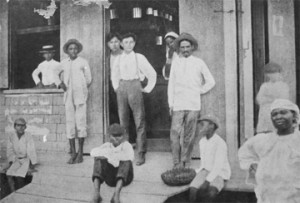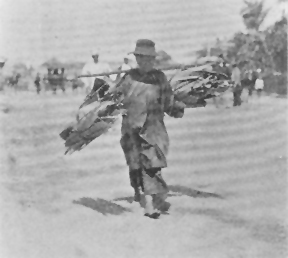Trev Sue-A-Quan is the author of two books on Chinese immigration in Guyana − Cane Reapers and Cane Ripples. He has now provided us with new insight into this topic with his latest article Casual Encounters which is reproduced below. Casuals were Chinese non-indentured workers who came from other West Indian islands and territories in the region during the period of indentureship. Even after the use of the term ‘casual’ was discontinued following the end of Chinese indentureship in 1879, Chinese immigrants have still continued to come. Many of their children have made an impact on Guyanese society, eg Dr Leslie Chin, Messrs Philip and Denis Yeung, Randolph Choo-Shee-Nam, Benjie Cho Chung Hing, Ashton Wan Ping and Vibert Choo-A-Fat.
Incidentally, April 3, 2009 will mark the 149th anniversary of the arrival of the Dora which brought the first Chinese women to Guyana. (Marlene Crawford)
By Trev Sue-A-Quan
The history of the arrival of Chinese in Guyana during the 19th century is now quite well established, and this history has been commemorated by the erection in 1986 of a monument in Windsor Forest, West Coast Demerara, dedicated to those early Chinese immigrants.

The first boatload of Chinese consisting of 262 men landed in Georgetown in 1853. Such transhipments of Chinese labourers continued in subsequent years and ended in 1879 after 39 ships had brought a total of 13,541 Chinese. The use of indentured labourers did not end at that time but lasted until World War I as labourers from India continued to be introduced. The period of indentured labour contracts thus extended from the 1830s to the early 20th century.
A number of accounts, particularly in more recent years, have appeared in newspaper articles, books and on the internet describing the experiences of Chinese descendants. In general, most of the Chinese who decided to remain in the colony ventured into business and trade, particularly shopkeeping, while later generations pursued careers based on academic studies (including the civil service which was ready to accept qualified high school graduates).

After completing the service of indenture each labourer was issued a Certificate of Temporary Industrial Service signifying that he was free of contractual obligation as well as giving him the right to roam freely across the land without fear of incarceration. The Chinese faced stiff competition from the Portuguese who had previously completed their own terms of indenture and had become established in trade and commerce. This caused a number of free Chinese to migrate to neighbouring countries to seek better opportunities there, some going as far away as Panama. At the same time some Chinese workers in these neighbouring countries decided to migrate to Guyana because they thought they had better prospects here of obtaining a Chinese wife.
The first batches of Chinese workers in Guyana had made a sufficiently strong impression on their employers that a demand grew for more shipments of these labourers. The authorities recognized that for a stable contingent of Chinese to become established Chinese females would have to be recruited. This was not an easy task, since Chinese women did not traditionally accompany husbands who had to go to distant places in pursuit of employment. Encouragement in the form of a bounty of $50 was offered to each man who came with a wife. In some cases this resulted in the formation of ‘instant’ marriages, where prospective emigrants enlisted women to become their spouses (at least on paper) immediately prior to boarding the ships. Whether or not the brides were fully informed of the monetary value they brought to the union is a matter of speculation, and the bounty system was subsequently abolished.
A number of families were persuaded through the efforts of Christian missionaries in China that a trip abroad might be a good thing. This was especially so after the defeat of the Taiping Rebellion, the leader of which was a man who believed himself to be the younger brother of Jesus Christ and who drew much support from the Hakka people in southern China. The rebellion was crushed by imperial troops loyal to the emperor in Beijing. The civil conflict claimed an estimated 20 million lives and many candidates for emigration became available when the victorious forces sought to wipe out the remaining participants in the uprising.
The first ship transporting Chinese women to Guyana was the Dora which landed on April 3, 1860, with 383 Chinese including132 women and girls. They were from a Hakka community and were led by a local pastor who had converted to the Christian faith. Of the 13,541 Chinese who arrived in Guyana during the period of indenture 2,027 were females, or 15%. Although seemingly small, this number of women still represented a relatively high proportion of females among emigrating working groups. By contrast not a single one of the Chinese labourers who were shipped to Cuba was female. The Dutch did little better in populating their Suriname plantations. In Trinidad 309 Chinese women (10%) landed there, and Jamaica drew a comparable proportion among their 1,152 Chinese immigrants. In those days the prevailing opinion was that inter-racial marriage should not be encouraged. A number of freed Chinese went against the norm and formed unions with locals of other races, but the primary interest was in marrying persons of their own kind. This sentiment caused Guyana to become a ‘field of dreams’ for prospective Chinese bachelors in the Caribbean region.
The arrival in Guyana of Chinese migrants from other countries in the Caribbean resulted in a new category of immigrant because they were free of indenture at a time when many of the local Chinese had not completed their terms of service. In the 1860s the Immigration Office began a ‘Register of Immigrants Arriving in the Colony of British Guiana from the Adjacent West India Islands and Other Countries.’ In colloquial but formally accepted terms they were recorded as ‘Casuals.’ Suriname became a source of many casuals. Between 1853 and 1874 a total of 2,630 Chinese indentured labourers had been taken to Suriname on 20 ships. Being essentially a step and a jump across a river, Guyana saw something of an influx of Chinese men seeking to find wives and raise families.
An indication of a Dutch connection could be detected in some names such as Tjin-A-Fat which would otherwise be written as Chin-A-Fat by an English scribe. They began a new life in a location that previously was controlled by the Dutch who had bequeathed names such as Stabroek, Werk-en-Rust, Uitvlugt and many others. One of the lists of casuals shows that the vast majority were in their late 20s and older, and that they originated from Nickerie, Paramaribo, Cayenne, Barbados, Jamaica and Trinidad. Although a complete listing has not been located, casuals appear to have numbered a few hundred.
Some of the casuals signed contracts of indenture to work on sugar estates, since that was the established and readily available way to secure employment. Others went into shop-keeping as a means of livelihood. These casuals became integrated into the society like their Chinese compatriots who arrived directly from China. One person who arrived from Suriname was Gerhard Tjon-A-Kien, who was the father of ten children; later generations became successful in business and as medical practitioners. Archival documents show that Fung Kee Fung was also a casual, although his place of origin is not stated. His descendants made the surname Fung-Kee-Fung well known in business, medical and legal fields.
One of the notable casuals from Trinidad was Joseph Chung A Chong whose son, Arthur Chung, became a lawyer and was later chosen to become the first president of the independent Republic of Guyana. Joseph Chung A Chong was born in Canton in 1876 and first immigrated to Trinidad. He then moved to Guyana for a while. In 1901 he obtained a British Guiana passport enabling him to return to Trinidad where he was fortunate to find a spouse, Lucy Awai, with whom he had four children before taking the family to Guyana. The Chungs settled in Windsor Forest where four other children, including Arthur, were born.
It is not clear exactly when the title ‘casual’ fell into disuse to describe the independent immigrants, but most likely at the turn of the century when a new type of Chinese settler began to arrive. These came directly from China where making a living was a harsh proposition and they maintained strong attachments to the land of their birth, such that wives could be sought from or through contacts with their home villages. In the Caribbean area, Jamaica was one of the places that saw a significant surge of these new Chinese arrivals. Eventually others in the family such as brothers, cousins and other relatives joined them in running the shops that they opened. Their decision to immigrate to a remote place half a world away was based primarily on economic considerations and not made in a casual manner.
